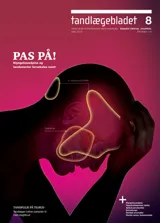Klyngehovedpine (Hortons hovedpine) – karakteristik og fællestræk med tandsmerter
Klyngehovedpine er en smertefuld hovedpineform med betydelige konsekvenser for livskvalitet samt sociale og erhvervsmæssige forhold. De næsten uudholdelige smerteanfald er lokaliseret unilateralt til øjen-, tindinge- og overkæberegionen. Da patienterne med klyngehovedpine typisk oplever smerter i relation til kæber og tænder, henvender de sig ofte til tandlæge, inden hovedpinediagnosen bliver stillet. Vi foretog en spørgeskemaundersøgelse af smertelokalisation –karakteristika og eventuel behandling hos 11 patienter med klyngehovedpine og 20 patienter med akutte tandsmerter. Undersøgelsen viste et mindre sammenfald af symptomer, men også betydelige forskelle. Fire af patienterne med klyngehovedpine havde opsøgt deres tandlæge for deres smerter, og to havde fået irreversible og formodentlig unødvendige tandbehandlinger. De tydeligste forskelle mellem tandsmerter og klyngehovedpine var de udløsende og provokerende faktorer i form af kemisk, termisk og mekanisk stimulation af tænderne ved førstnævnte, og indtagelse af alkohol sammen med karakteristiske autonome ledsagesymptomer som tåreflåd og øjenrødme ved klyngehovedpine. Kendskab til hovedpinen er derfor af betydning for tandlæger, selvom diagnostik oftest og behandling altid foregår i lægeligt/neurologisk regi.
Cluster headache (Horton’s disease) – characteristics and similarities with tooth pain
Cluster headache is a painful headache with major consequences for life quality, social relations and occupation. the almost intolerable attacks of pain are unilateral, localized to the orbital, temporal and maxillary region. as patients with cluster headache often experience pain in the jaws and teeth, they may contact their dentist before they are diagnosed. the pain location, type and possible treatment were recorded with a questionnaire with 11 patients with cluster headache and 20 patients with acute tooth pain. the investigation showed a minor overlap of symptoms, but also signifi cant differences. Four patients with cluster headache had consulted their dentist for pain treatment, and for two these visits resulted in irreversible and probably unnecessary dental treatments. the most marked differences between tooth pain and cluster headache were the eliciting and provoking factors of chemical, thermal and mechanical stimulation of teeth, and the consumption of alcohol together with the characteristic concomitant autonomic symptoms associated with cluster headache. Knowledge of the headache is therefore important for dentists, even though diagnostics and treatment are medical.


